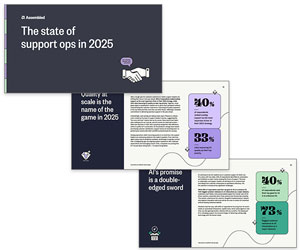We examine lots of research to find out how contact centres of different sizes are driving more value from their Workforce Management (WFM) solutions.
Use of Workforce Management Solutions
Almost all (92%) call centres use some form of workforce management solution, even if it is just a simple set of Excel macros that have been developed in-house over the years.
Just over half (53%) use a third-party application and 20% use a formal in-house developed application. (NB figures add up to more than 100%, as respondents may use more than one variety of workforce management solution).
More details of our research is highlighted in the table below.
| Type of WFM Solutions | Proportion of Respondents Using WFM That Use This Functionality |
|---|---|
| Third-party application | 53% |
| In-house development | 20% |
| Excel spreadsheet or similar | 56% |
| None | 8% |
We then split this research by contact centre size.
| Type of WFM Solutions | Small | Medium | Large | Average |
|---|---|---|---|---|
| Third-party application | 34% | 44% | 84% | 53% |
| In-house development | 19% | 25% | 17% | 20% |
| Excel spreadsheet or similar | 61% | 62% | 43% | 56% |
| None | 14% | 7% | 3% | 8% |
What we can gather from these results is that there is little real difference in workforce management implementation across vertical markets, as the main driver for this is complexity of operation and
potential cost savings through optimising a large workforce.
As such, these factors are more prevalent in large contact centres, where 84% of respondentsuse a third-party workforce management solution that is more likely to be capable of long-term forecasting models, real-time adherence and calculating the effects of agent-initiated vacation requests.
Use of Workforce Management By Contact Centre Size
The following graph really helps to bring the data provided in the tables above to life.

This helps to illustrate that small contact centres are still very heavily involved in manual workforce management, which offers extremely limited opportunities for doing anything other than a static schedule that cannot easily be changed. In fact, forecasting and scheduling in this scenario is more of an art than a science.
Medium and large operations are far more likely to use dedicated third-party workforce management applications which historical data can be fed into, providing a far more accurate schedule.
The low take-up of third-party workforce management tools in smaller centres is almost certainly down to cost, the fact that the time taken to create a manual schedule for 10 agents is far less than for 100 agents, and because the manager of a small contact centre does not need the flexibility or capabilities that a large operation can benefit from, as their labour and skills pool is so much shallower to begin with.
However, it is certain that most contact centres of perhaps 25 seats upwards could benefit from more accurate forecasting and scheduling, and such businesses could look at the hosted or SaaS (software-as-a-service) model that many solution providers now offer.
Increasing Use of WFM systems
The Planning Forum’s 2010 benchmark research highlights that Workforce
Management systems are more commonplace than ever before, with 82% of centres having a system and another 4% considering imminent implementation.
- Looking back to the first survey carried out in 2002, only 68% had a system. Now practically all centres over 250 seats (96%) have a system in place – showing the value these systems can provide to businesses.
- The centres who haven’t invested are predominantly single site, 90% of whom are less than 250 seats. This shows that size and number of sites is a key determining factor as to when we should invest
- 10% of centres are seriously considering a change in the next 12 months – a figure that has been constant over the past decade. This may suggest that systems have a lifespan within a company or may reflect management or organisational changes
There are signs that the market is consolidating with four dominant players in the UK & Ireland market. There are some differences based on centre size and structure.
The sector segmentation below, based on data provided by The Forum, shows some interesting patterns:
- 43% of outsourcers use IEX
- 70% of utility companies use Aspect (35%) or Verint (35%)
- 60% of Public Sector centres have Q-Max (33%) or Verint (27%)
- 40% of financial services centres use Aspect (23%) or Verint (17%)
This research was conducted with replies from 160 companies – representing 715 sites, 175,000 agents and 2,168 planners.
Thanks to Steve Morrell of ContactBabel for sharing many of the insights that have been presented in this article.
For more advice on better utilizing Workforce Management (WFM) technology, read our articles:
- Beginner’s Guide to Workforce Management Software
- 17 Resource Planning Tools and Techniques You Should Know
- An Introduction to… Workforce Management Applications
Author: Jonty Pearce
Published On: 18th Mar 2010 - Last modified: 13th Aug 2025
Read more about - Workforce Planning, ContactBabel, Forecasting, Steve Morrell, The Forum, Workforce Management (WFM), Workforce Planning










































